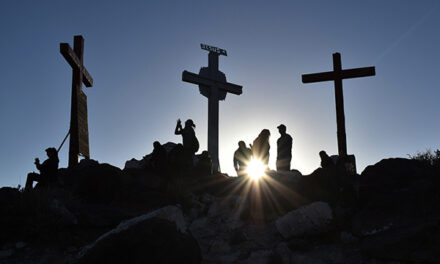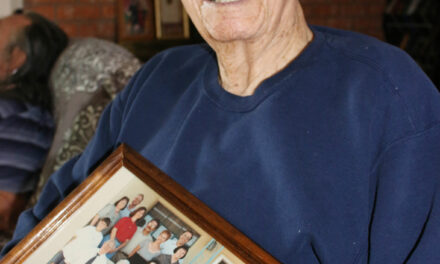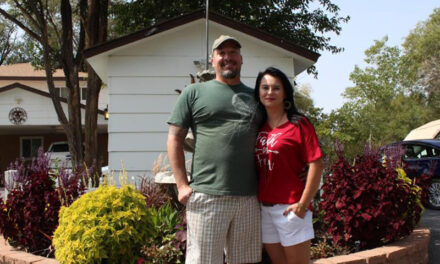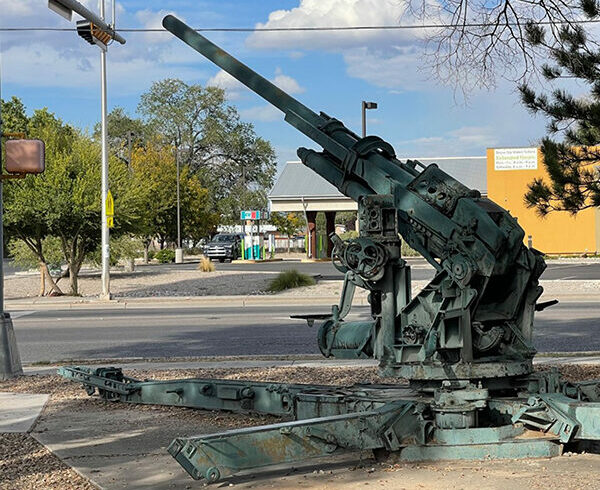
Photo courtesy of John Taylor
The M1A1 90-mm anti-aircraft gun in Solomon Luna Park in Los Lunas.
La Historia del Rio Abajo
How many times have you driven down Main Street in Los Lunas, past the Champion car wash, the water/antenna tower, and the Los Museum of Heritage and Arts?
As you drove by, how many of you have even noticed the anti-aircraft gun pointing skyward from the corner east of the museum? In fact, that gun has a significant history, not only for Los Lunas but for all of New Mexico.
The location
The grassy area on the southwest corner of the intersection of Main Street and Luna Avenue in Los Lunas is called Solomon Luna Park, and is part of the Los Lunas Schools District.
It sits adjacent to the school district’s Special Services building, formerly the administrative headquarters for Los Lunas Schools, which, in turn, is adjacent to Los Lunas Middle School, formerly Solomon Luna High School — the first and only high school in Los Lunas from 1926 until 1969.
The donation
The anti-aircraft gun displayed in Los Lunas saw action during World War II, and was one of 11 donated to various municipalities in New Mexico by the New Mexico National Guard in 1959.
American Legion Post 85 placed the gun in the Solomon Luna Park in March 1959. Jack Lovato, the vice-commander of Post 85 (and the father of Jack Lovato Jr., a life member of both American Legion Post 81 in Belen and the Daniel D. Fernandez Veterans of Foreign Wars Post 9676 in Los Lunas), accepted the donation on behalf of the village and the school district.
The nine-ton gun was installed on a concrete slab provided by the American Legion. The installation originally included a flagpole and a plaque, and the entire display was fenced. The mounting hole for the flagpole, the holes where a fence was originally installed, the gun itself, and a heavily weathered memorial plaque are all that remain today.
The plaque reads, “In memory of the veterans of all wars, Post 85.” The logo of the American Legion is in the middle of the plaque.
Originally, the intent was to have a daily flag-raising ceremony, conducted by students from the high school, at the memorial. It is not clear if that rite was ever performed, but it certainly has not been performed for several decades.
The flagpole and fencing may have been removed when another flagpole was erected just a few yards to the east in front of the school district’s former administrative headquarters.
The installation of guns like the Los Lunas gun in city parks was not without some peril. One problem was that they were an “attractive nuisance,” but were still fully operational. Children would climb on the gun, and if another child playing on the guns moved one of the wheels or levers causing the mechanism to move, the climbing child could get caught in its mechanisms.
Belen had at least one child caught in the mechanism of its gun, and the fire department was called to free him. A gun in Bataan Park in Albuquerque had a similar misadventure.
Eventually, clearer minds prevailed, and the guns’ operating mechanisms were disabled. Many of the guns in towns around the state, including the ones in Belen and Albuquerque, were subsequently removed, and those that remained slowly became part of the landscape.
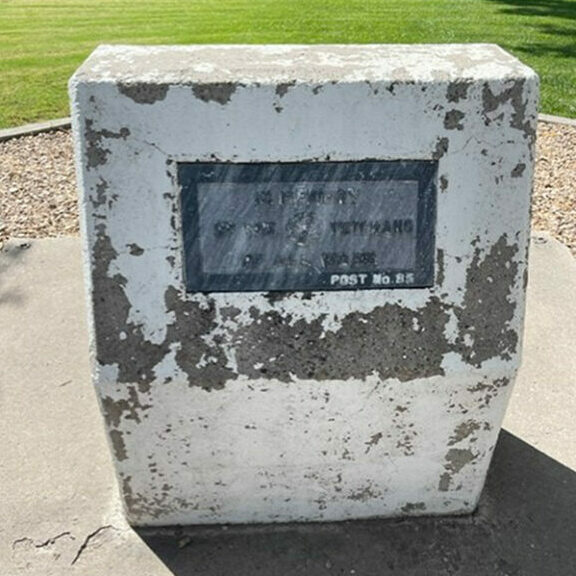
Photo courtesy of John Taylor
Plaque behind the Los Lunas anti-aircraft gun.
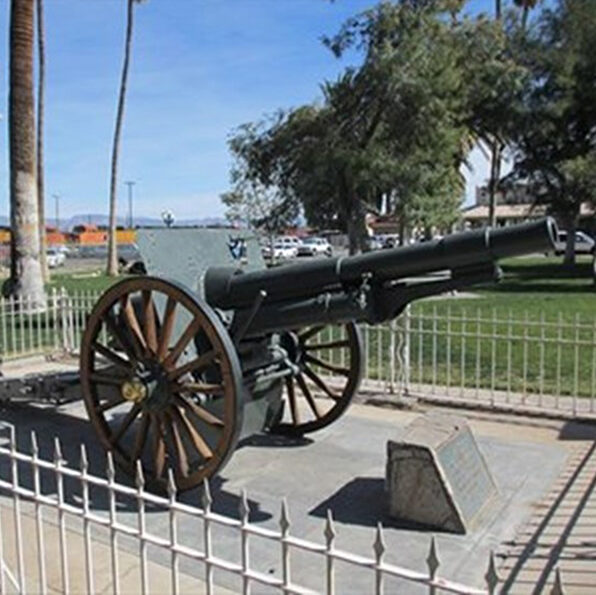
Photo courtesy of waymarking.com
World War II cannon in front of El Garces, the former Harvey House in Needles, California
Significance
A long-standing tradition across the United States, and many other countries as well, is to have memorial locations which recognize the contributions of a particular city or town to the various military conflicts in which people from the city or town have fought, been injured or given their lives.
Military hardware, especially cannons, guns, tanks and other obvious weapons of war, were frequently chosen, along with obelisks or statues representing the contribution of the municipality to the war effort. It is hard to travel through towns and villages in Europe without seeing these monuments, often in a place of honor in the center square of the municipality and some of which memorialize events as far distant as the Middle Ages. Many small towns across the United States have similar memorials.
While these memorials were much in favor in the United States from the Revolutionary and Civil wars through World War II, they became less popular with the controversies surrounding the Vietnam War.
Nowadays, individuals are more frequently recognized as distinct from the conflicts themselves. A notable local example is the naming of the park on South Route 314 for Vietnam Medal of Honor recipient Daniel D. Fernandez.
History and details of the anti-aircraft gun
The United States had deployed 3-inch (75 millimeter) anti-aircraft guns prior to World War II. However, after World War I, as aircraft became a much more effective military weapon, the Army became interested in a more capable anti-aircraft weapon.
On June 9, 1938, it issued a development contract calling for new guns, including one with a slightly larger caliber (3.5 inches or 90-mm), which it felt was the largest possible size that was still capable of being manually loaded while the barrel was trained at high elevations. By 1940, an advanced version of the 90-mm design, was standardized as the 90-mm M1.
After a few hundred M1s were completed, several improvements were added to produce the 90-mm M1A1, which was accepted on May 22, 1941. The M1A1 included an improved mount and spring-rammer on the breech, with the result that the gun could fire up to twenty high-explosive projectiles per minute, each weighing about 20 pounds. These guns could engage targets flying as high as 30,000 feet.
Initially, these projectiles required a direct hit to explode. During later phases of the war, proximity fuses, which had been developed and tested at Kirtland Army Air Field (now Kirtland Air Force Base) in Albuquerque, were added to improve the effectiveness of the weapon.
Several thousand of these anti-aircraft guns were available when the U.S. entered World War II, and the M1A1 was the standard anti-aircraft gun for the rest of the conflict.
During the war, the Coast Artillery Corps adopted the 90-mm M1A1 to supplement or replace aging 3-inch guns in harbor defense commands in the Continental United States (CONUS) and in U.S. territories. The artillery groups were typically organized with four 90-mm anti-aircraft guns and two smaller 37-mm or 40-mm anti-aircraft guns each.
Typically, two of the 90-mm guns were on fixed mounts and two were in towable configurations. Emplacements for at least 90 batteries of two fixed guns each, plus mobile weapons, were constructed in CONUS, Panama, Alaska, Hawaii, Puerto Rico, the Philippines and elsewhere.
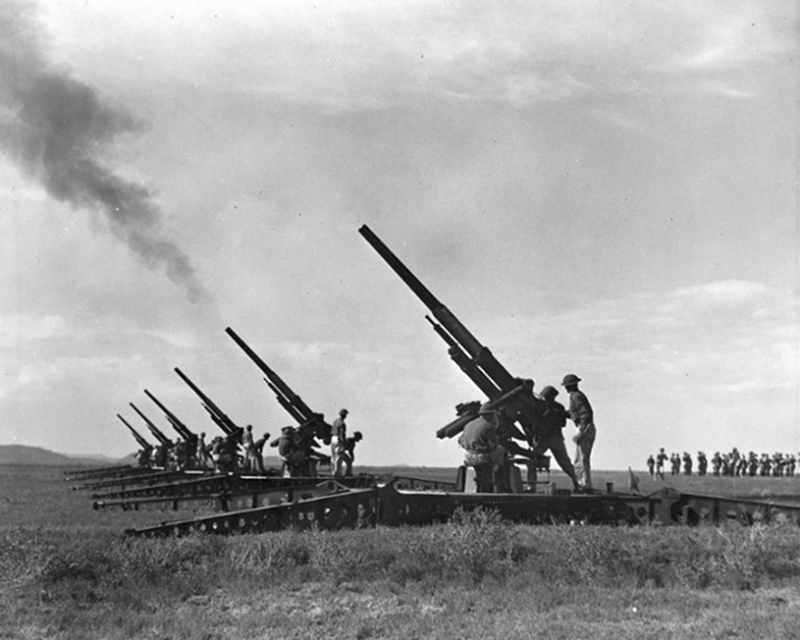
Photo courtesy of Museum of New Mexico
Members of New Mexico National Guard training with 90-mm anti-aircraft guns at Camp Luna prior to deployment to the Philippines.
New Mexico and the defense of Bataan
More than 50,000 New Mexicans served in World War II. One of the major deployments of these soldiers was the air defense of Bataan, a critical peninsula on the island of Luzon in the northern Philippines. A total of 1,825 New Mexico National Guardsmen, all members of the 200th and 515th Coast Artillery units, were among the soldiers who manned these air defense positions. These units were equipped with the 90-mm M1A1 anti-aircraft guns.
After training at Camp Luna near Las Vegas in northern New Mexico, the New Mexicans were deployed to the Philippines in mid-1941.
The Japanese military felt that it had to control the Philippine Islands to secure critical supply lines in the South China Sea between the Japanese home islands and the oil-rich regions of Southeast Asia. Their attacks on the Philippine Islands were fierce and relentless.
The Coastal Artillery units on Bataan, staffed by well-trained New Mexico soldiers, provided critical anti-aircraft defense against these attacks.
By April 1942, however, despite heroic actions, the defenders of Bataan were running out of ammunition and supplies. On April 9, 1942, their commander, Gen. Honathan Wainwright, was forced to surrender to the overwhelming Japanese forces.
Thousands of Wainwright’s men, along with many Filipinos, were forced to march from Bataan to prison camps, some 60 miles away enduring the blazing tropical heat with little to eat or drink and no care for wounded or sick men. Men died or were bayoneted by Japanese soldiers or were just left to die along the way.
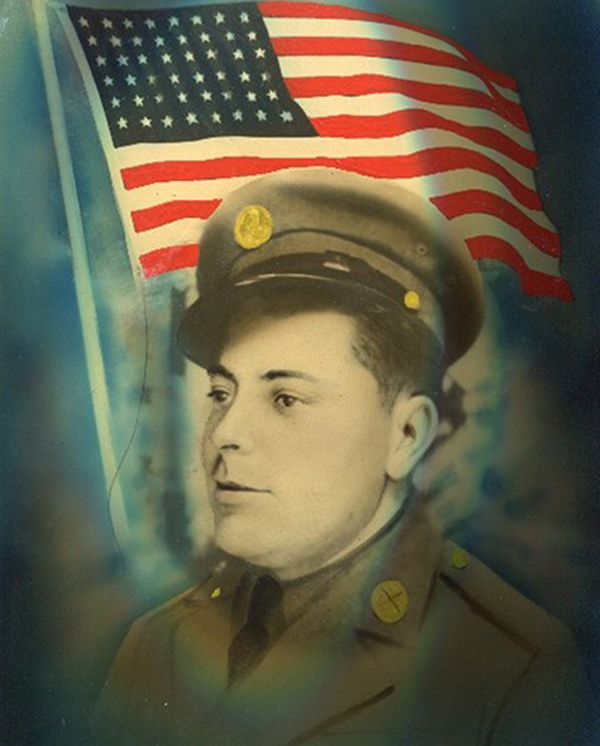
Photo courtesy of the Chavez family
Clovis Chavez was a Bataan Death March survivor.
The march would come to be known as the Bataan Death March. Nearly one-third of all New Mexico World War II casualties occurred during the death march and the imprisonment that followed.
Of the 1,825 New Mexicans who originally deployed in 1941 and who were forced to endure these terrible ordeals, 1,138 survived and returned to New Mexico after the war. Virtually all of the returnees were permanently scarred, either physically or emotionally or both, by their time in the Philippines.
Several of the veterans of the Bataan Death March were from Valencia County, including Clovis Chavez who later became the postmaster in Peralta.
In fact, so many Rio Abajo soldiers died during the Bataan Death March or were subsequently incarcerated in prisoner of war camps in the Philippines or in Japan that when famed New Mexico santero Carlos Otero carved the retablo for the Church of Our Lady of Guadalupe in Peralta, he included a panel showing Santo Niño de Atocha, the patron saint of pilgrims and prisoners.
Several other memorials have been erected to remember the sacrifices made by Valencianos during World War II. These include the crosses on Tomé Hill, the anti-aircraft gun in Belen (which has been removed), a memorial in Jarales and a memorial in front of the Church of the Immaculate Conception in Tomé.
Collective memory
Memorials, such as the anti-aircraft gun in Los Lunas and the others mentioned above, represent a part of the collective memory of places and times. I submit that it is important that we do not lose these memories.
We place monuments and name parks, schools and buildings for individuals or events, but too soon, new crises arise, the rush of day-to-day life intervenes, and the rationale for raising these monuments and honoring these individuals fades in our rear-view mirrors.
The mere passage of time does not lessen the importance of the people and events that we honored when the monuments were installed or the facilities named.
Perhaps it is time to refurbish the Los Lunas memorial and, by doing so, remind everyone of the heroism and sacrifice that it represents.
(La Historia del Rio Abajo is a regular column about Valencia County history written by members of the Valencia County Historical Society. The authors of this month’s column are John Taylor and the late Jim Sloan.
John is a retired engineer from Sandia National Laboratories and Board Member of the Valencia County Historical Society. He is the author or co-author of 21 books on New Mexico history.
Jim Sloan was the photography curator at the Belen Harvey House Museum, a member of the Board of Directors of the Valencia County Historical Society, and a long-time contributor to history-related writing and discussions in the Rio Abajo. He passed away recently and is terribly missed by all his friends and family in Valencia County. His research was critical to the completion of this article.
Opinions expressed in this and all columns of La Historia del Rio Abajo are the author’s only and not necessarily those of the Valencia County Historical Society or any other group or individual.)

